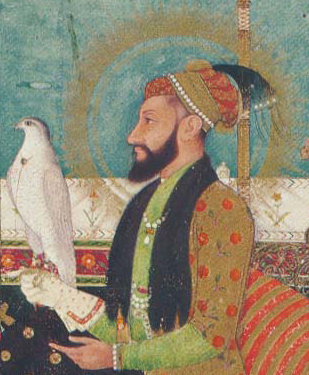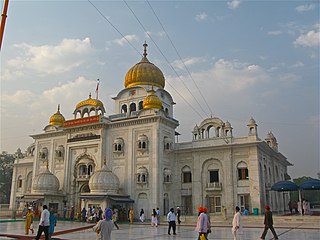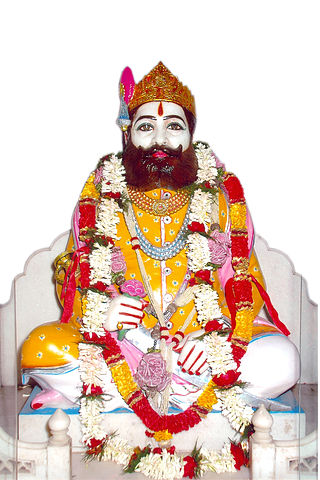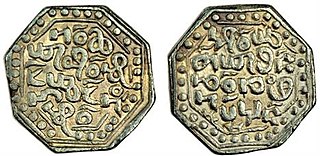| |||||
| Centuries: | |||||
|---|---|---|---|---|---|
| Decades: | |||||
| See also: | List of years in India Timeline of Indian history | ||||
Events from the year 1552 in India.
| |||||
| Centuries: | |||||
|---|---|---|---|---|---|
| Decades: | |||||
| See also: | List of years in India Timeline of Indian history | ||||
Events from the year 1552 in India.

Muhi al-Din Muhammad, commonly known as Aurangzeb and by his regnal name Alamgir I, was the sixth Mughal emperor, reigning from 1658 until his death in 1707. Under his emperorship, the Mughal Empire reached its greatest extent with territory spanning nearly the entirety of the Indian subcontinent.

Guru Tegh Bahadur was the ninth of ten gurus who founded the Sikh religion and was the leader of Sikhs from 1665 until his beheading in 1675. He was born in Amritsar, Punjab, India in 1621 and was the youngest son of Guru Hargobind, the sixth Sikh guru. Considered a principled and fearless warrior, he was a learned spiritual scholar and a poet whose 115 hymns are included in the Guru Granth Sahib, which is the main text of Sikhism.

Srimanta Sankardev was a 15th–16th century Assamese polymath; a saint-scholar, poet, playwright, dancer, actor, musician, artist social-religious reformer and a figure of importance in the cultural and religious history of Assam, India. He is widely credited with building on past cultural relics and devising new forms of music (Borgeet), theatrical performance, dance (Sattriya), literary language (Brajavali). Besides, he has left an extensive literary oeuvre of trans-created scriptures, poetry and theological works written in Sanskrit, Assamese and Brajavali. The Bhagavatic religious movement he started, Ekasarana Dharma and also called Neo-Vaishnavite movement, influenced two medieval kingdoms – Koch and the Ahom kingdom – and the assembly of devotees he initiated evolved over time into monastic centers called Sattras, which continue to be important socio-religious institutions in Assam and to a lesser extent in North Bengal. Sankardev inspired the Bhakti movement in Assam just as Guru Nanak, Ramananda, Namdev, Kabir, Basava and Chaitanya Mahaprabhu inspired it elsewhere in the Indian subcontinent.

The Ahom dynasty (1228–1826) ruled the Ahom Kingdom in present-day Assam, India for nearly 598 years. The dynasty was established by Sukaphaa, a Shan prince of Mong Mao who came to Assam after crossing the Patkai mountains. The rule of this dynasty ended with the Burmese invasion of Assam and the subsequent annexation by the British East India Company following the Treaty of Yandabo in 1826.

Gurdwara Bangla Sahib is one of the most prominent Sikh gurdwaras, or Sikh house of worship, in Delhi, India, and known for its association with the eighth Sikh Guru, Guru Har Krishan, as well as the holy pond inside its complex, known as the "Sarovar." It was first built as a small shrine by Sikh General Sardar Baghel Singh in 1783, on the bungalow donated by king Raja Jai Singh of Amer, who supervised the construction of nine Sikh shrines in Delhi in the same year, during the reign of Mughal Emperor, Shah Alam II.

The Sikh Empire was a regional power based in the Punjab region of South Asia. It existed from 1799, when Maharaja Ranjit Singh captured Lahore, to 1849, when it was defeated and conquered by the British East India Company in the Second Anglo-Sikh War. It was forged on the foundations of the Khalsa from a collection of autonomous misls. At its peak in the 19th century, the empire extended from Gilgit and Tibet in the north to the deserts of Sindh in the south and from the Khyber Pass in the west to the Sutlej in the east as far as Oudh. It was divided into four provinces: Lahore, which became the Sikh capital; Multan; Peshawar; and Kashmir from 1799 to 1849. Religiously diverse, with an estimated population of 4.5 million in 1831, it was the last major region of the Indian subcontinent to be annexed by the British Empire. Some of the notable Commander-in-Chief of the Sikh Empire were Misr Diwan Chand, Hari Singh Nalwa and Diwan Mokham Chand.

The Dimasa Kingdom was a late medieval/early modern kingdom in Assam, Northeast India ruled by Dimasa kings. The Dimasa kingdom and others that developed in the wake of the Kamarupa kingdom were examples of new states that emerged from indigenous communities in medieval Assam as a result of socio-political transformations in these communities. The British finally annexed the kingdom: the plains in 1832 and the hills in 1834. This kingdom gave its name to undivided Cachar district of colonial Assam. And after independence the undivided Cachar district was split into three districts in Assam: Dima Hasao district, Cachar district, Hailakandi district. The Ahom Buranjis called this kingdom Timisa.

Suhungmung, or Dihingia Roja I was one of the most prominent Ahom Kings who ruled at the cusp of Assam's medieval history. His reign broke from the early Ahom rule and established a multi-ethnic polity in his kingdom. Under him the Ahom Kingdom expanded greatly for the first time since Sukaphaa, at the cost of the Chutia and the Dimasa kingdoms. He also successfully defended his kingdom against Muslim invasions, first by a general called Bar Ujjir and another by Turbak Khan. During his time, the Khen dynasty collapsed and the Koch dynasty ascended in the Kamata kingdom. His general, Ton-kham, pursued the Muslims up to the Karatoya river, the western boundary of the erstwhile Kamarupa Kingdom, the farthest west an Ahom military force had ventured in its entire six hundred years of rule.
Supaatpha also, Gadadhar Singha, established the rule of the Tungkhungia clan of the Ahom kings that ruled the Ahom kingdom till its climactic end. He was the son of Gobar Roja, a descendant of Suhungmung, and who had become the king for a mere 20 days. Previously known as Godapani, Supatphaa was able to stabilize the kingdom after the decade-long turmoil following the Ahom victory in the Battle of Saraighat. This period saw the ruthless power grab of Debera Borbarua and Laluksola Borphukan's abandonment of Guwahati and oppression via Sulikphaa Lora Roja. Supatphaa retook Guwahati from the Mughals for good, and established a strong rule of 'blood and iron'. He came into conflict with the Moamoria Vaishnava sattra which belonged to the folds of Kal "songhoti"and made way for Rudra Singha, his son and succeeding king, to take the kingdom to its zenith.

Garhgaon is a town in Assam, India and was the capital of the Ahom kingdom for many years. It was built by the Ahom king Suklenmung in 1540. Suklenmung who interverned against a Toungoo dynasty attack on MongKwang in Kachin State of Myanmar was married to the princess Nang Sao Seng, the daughter of Chao Siu-Kwei of MongKwang. It is said that the Ahom capital Garhgoan was built at the suggestion of this Mong Kwang queen Nang Sao Seng In 1575, Mongkwang king Chao Ka Pha II took shelter in Ahom territory after his state was devastated by the Burmese. It lies 13 km east of present-day Sivasagar town, headquarters of Sivasagar district. The palace structures were made of wood and stones. In 1747 Pramatta Singha, son of Rudra Singha, constructed the brick wall of about 5 km in length surrounding the Gargaon palace and the masonry gate leading to it.
Bakata was the capital of the Ahom kingdom established by the Ahom king Suhungmung (1497–1539) in the 16th-century. Since his capital was by the Dihing river, Suhungmung is also known as the Dihingia Raja. The next king, Suklenmung (1539–1552), moved the capital to Garhgaon. The place is recorded in the Chinese chronicle Ming Shilu and is referred to as Bajiata. Before it became the Ahom capital in the early 16th century, the Ming Shilu describes it as a polity subordinate to Da Gu-la, an unidentified polity located somewhere in modern-day Northern Burma or Assam.
Lanka is a town located in Hojai District of Assam, and a town area committee with 11 wards. It serves as a trade and commerce hub for nearby areas such as Udali, Nokhuti, Laskar Pather, Karikhana, Kheroni, Dablong, and Doiyong sides. It is connected to other cities/states such as Guwahati by NH27.

Agrahari, Agraharee or Agarhari is an Indian and Nepali Vaishya community, They are the descendants of legendary king Agrasena. Predominantly, they are found in the Indian state of Uttar Pradesh, Madhya Pradesh, Jharkhand, Chhattisgarh and Terai region of Nepal.

Suklamphaa also Ramadhwaj Singha was a king of the Ahom kingdom. His reign is known for the rise in power of Debera Borbarua and the beginning of a ten-year period of power struggles among high officials of the kingdom that saw quick changes in kings via court intrigues and internal armed conflicts.

Suklenmung(1539–1552) was a king of the Ahom kingdom in medieval Assam. Since he established his capital at Garhgaon, he is also called the Garhgaiya roja in the Buranjis. It was during his reign that Madhabdev and Sankardeva's son-in-law Hari were captured and Hari executed, which precipitated the departure of Sankardeva from the Ahom kingdom.

Sunyatphaa also Udayaditya Singha was the king of Ahom Kingdom from 1670 CE to 1672 CE. After his elder brother Swargadeo Chakradhwaj Singha died in the middle of Ahom-Mughal war, Udayaditya Singha succeeded to the throne. His reign witnessed the end of Ahom-Mughal war, which started during the reign of Chakradhwaj Singha, when the Mughal army led by Rajput prince, Ram Singh I of Amber, was decisively defeated by the Ahom forces led by Ahom commander Lachit Borphukan in the Battle of Saraighat. The later part of his reign was characterized by the failure of military expedition against the Dafala tribes and the influence of Paramananda Sannyasi, a saintly figure from Brindaban, over Udayaditya Singha. Udayaditya's over exerted devotion towards Paramananda Sanyasi, aroused dissatisfaction among the nobles, which ultimately caused his deposition and execution. His reign was followed by a series of political anarchy and internal disturbances in the Ahom kingdom which continued till the accession of Gadadhar Singha in 1681 CE.
Events from the year 1534 in India.
Events from the year 1539 in India.
Events from the year 1535 in India.
The Koch–Ahom relations (1532–1571) refer to the diplomatic, strategic and military relationships between the Koch and the Ahom kingdoms over the control of the Brahmaputra Valley. Though an initial contact between the Ahoms and Koch occurred during Biswa Singha's reign, the relationship became belligerent with Nara Narayana ascending to power and consolidating his hold over the western portion of Assam; and it ended with the failure of Chilarai's campaign against Sulaiman Karrani. This was followed by an alliance that soon gave way to a fierce conflict between the Ahoms and the Mughals.